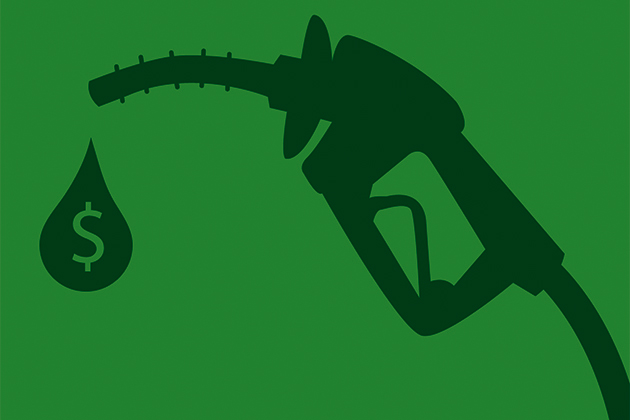Oil prices have plunged in the past four months – the biggest decrease in more than two years – amid a surge in supply, moderate global demand, and reluctance among many of the large Middle Eastern producers to reduce their output. These factors, combined with the apparent discord among OPEC (the Organization of the Petroleum Exporting Countries that control about one-third of the world’s oil supply), suggest lower oil prices may be here to stay for the foreseeable future. However, OPEC is scheduled to hold its next meeting in Vienna this week (Nov. 27), and this could have major ramifications for the world’s leading oil-producing countries and the oil industry.
UConn Today invited Oksan Bayulgen, an associate professor of political science whose research specialties include the political economy of energy and the politics of oil, to offer her analysis of the latest developments. Her work includes several peer-reviewed articles on oil wealth, and the book Foreign Investment and Political Regimes: The Oil Sector in Azerbaijan, Russia, and Norway (Cambridge University Press, 2010).
Q – Gasoline prices in the U.S. are the lowest they’ve been in four years. Why?
A – About 68 percent of the price of gasoline is affected by the global price of crude oil, and the recent drop in those prices has to do with high global oil supplies and weaker than expected demand. The recovery of Iraqi and Libyan production, and increases in U.S. shale oil production, have all contributed to excess global supply. Some experts say the world is producing one million more barrels of crude daily than it needs. On the other side of the equation, oil prices have dropped as a result of lower Chinese growth, slow growth in Europe, and Japan’s recent slide back into recession. Of course, it does not help that the Saudis, who traditionally have been in a position to affect prices by altering supply, are refusing to cut back their production to force the oil price back up. Analysts say the reason for this is that Saudi Arabia no longer wants to lose market share to big non-OPEC producers like Russia and now – with the shale oil boom – to the U.S.
Q – Heating oil bills in New England will be trimmed by an average of about $360 this winter, according to the U.S. Energy Information Administration. What other price savings might Connecticut residents start to see from cheaper oil costs?
A – The biggest and most obvious savings will come from the drop in gasoline prices. It is estimated that at $3 per gallon of gasoline, compared to $4.50 per gallon, a typical family with two cars would save about $500 a year. These savings of course would have a huge impact on the broader economy. If translated into consumer spending, it would help boost economic activity in the country. Some commentators consider this the equivalent to a pre-holiday stimulus package. Also, typically in winter, people use their cars less (compared to the summer time), so winter gasoline prices tend to be cheaper than the summer prices. But again, for both heating oil and gasoline prices, crude oil prices matter the most. And those are determined by the overall supply and demand dynamics in the world.
Q – Are there other factors that also could push crude oil prices back up?
A – The biggest factor that could increase the global crude oil price is if, when OPEC meets this week, its members – especially the Saudis – decide to reduce their oil production. Unless the world demand for oil picks up all of a sudden (which is unlikely), only OPEC members’ decision to rein in production sharply to curb the amount of oil flowing into the market could have enough impact to drive prices back up in the short run.
Q – Since June, the price for gasoline in the U.S. has fallen by 49 cents to an average $3.59 a gallon nationally, which according to the U.S. Department of Energy, has added some $6 billion to American wallets. The agency forecasts gasoline will average $3.38 next year. Yet to really boost consumer spending, gasoline costs need to go down and stay down. Do you think that will happen?
A – I cannot predict how much lower the gasoline prices might go down. But I think there is a limit to how much the Saudis, Russians, Iranians, and U.S. shale oil producers can afford lower prices for their oil. Russia, Iran, and Venezuela need to average somewhere between $100 and $117 a barrel to balance their budgets for this year – oil exports are the only source of foreign earnings for these countries’ economies. So already their economies are suffering deeply from the drop in prices. And with the compounding effects of international sanctions in the case of Russia and Iran, there is growing concern that there will be social unrest soon.
The Saudis, with their large cash reserves, have more flexibility to absorb price drops for a breakeven oil price, but with oil currently trading around $75 a barrel, they are reaching that point very quickly, if they have not done so already. Even U.S. shale producers are getting close to the price limit beyond which further price drops at the pump will make it impossible for them to remain in business.
Q – In the past, OPEC has moved to cut or boost their collective output to try and influence price. Do you think OPEC will take action this week, to curb the amount of oil flowing into the global market?
A – I think they will take action this week, but the extent of the cuts will probably depend on the internal negotiations as well as the risks individual members will be willing to take. So I would like to think that these big OPEC producers would not, could not allow further price cuts. But amid infighting over expanded global production and how to broker a deal for a collective cut in output, this meeting is turning out to be a game of brinkmanship of sorts. It will depend on the cost/benefit calculations of these actors, and their ability and willingness to take risks on lost revenue to secure market share.
Q – According to the International Energy Agency, U.S. shale oil production is adding about one million barrels of oil a day to global supplies, thus contributing to the fall in crude prices. But shale production requires relatively high oil prices to make money. What incentive is there to keep OPEC from boosting production to flood the markets and undermine U.S. shale oil production?
A – Many experts have argued that the Saudi resistance to cut their output so far was designed to protect and increase their share in global oil markets, and by extension, to weaken Russia and Iran economically and politically. The other reason for the Saudi behavior may reflect their concern that the U.S. is becoming an important energy player and competitor, thanks to the shale revolution. So far they have not been successful in undermining U.S. shale production; largely because a lot of shale investment has already been locked in while drilling has become increasingly efficient, enabling the producers to withstand the effects of the price crash so far. Even though analysts say prices could slip to $75 to $80 a barrel before “fracking” shale projects would become unprofitable, others estimate the price could go down to as low as $60 a barrel before production halts. In my opinion, OPEC brinkmanship may leave no winners in the end, especially if these actors keep existing production quotas, and opt to wait until somebody blinks first.



